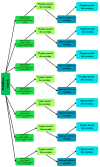Testing the Level of Cortisol in Dogs
- PMID: 40362012
- PMCID: PMC12070829
- DOI: 10.3390/ani15091197
Testing the Level of Cortisol in Dogs
Abstract
This paper focuses on cortisol levels in different dog matrices, emphasising the importance of non-invasive sampling for animal welfare and research ethics. The study reviewed over 18,000 articles from various databases, identifying 78 relevant studies that met the inclusion criteria. The findings reveal a growing trend for non-invasive matrices like saliva, hair, and urine, reliably reflecting acute and chronic stress responses while minimising animal stress during sampling. Other sample types, such as blood, are becoming less and less used due to their stress-inducing factors. Such an approach aligns with the growing concerns regarding animals' welfare during research design. Each sample type contributes a unique perspective, and the matrix choice depends on the research objectives. Rather than one being universally superior or more reliable, they offer complementary data that enhance our understanding of the animal's stress profile. Cortisol concentrations may be influenced by many factors, from environmental ones, such as living conditions, to genetic and social ones. This analysis focuses on the challenges often met during cortisol concentrations research, such as small sample sizes and lack of official assessment protocols. In the future, researchers should focus on an interdisciplinary approach by incorporating behavioural measures, other physiological indicators, and refining non-invasive methods. Those practices would enhance the understanding of canine welfare evaluation and promote a more ethical approach in clinical and practical settings.
Keywords: blood; claws; cortisol; dog; faeces; foetal fluids; hair; saliva; urine.
Conflict of interest statement
The authors declare no conflicts of interest. The funders had no role in the design of the study; in the collection, analyses, or interpretation of the data; in the writing of the manuscript; or in the decision to publish the results.
Figures





Similar articles
-
Welfare assessment in dairy cows using hair cortisol as a part of monitoring protocols.J Dairy Res. 2020 Aug;87(S1):72-78. doi: 10.1017/S0022029920000588. J Dairy Res. 2020. PMID: 33213571
-
Behavioral, Physiological, and Pathological Approaches of Cortisol in Dogs.Animals (Basel). 2024 Dec 7;14(23):3536. doi: 10.3390/ani14233536. Animals (Basel). 2024. PMID: 39682501 Free PMC article. Review.
-
Stress, the HPA axis, and nonhuman primate well-being: A review.Appl Anim Behav Sci. 2013 Jan 31;143(2-4):135-149. doi: 10.1016/j.applanim.2012.10.012. Appl Anim Behav Sci. 2013. PMID: 23459687 Free PMC article.
-
The Importance of Evaluating Positive Welfare Characteristics and Temperament in Working Therapy Dogs.Front Vet Sci. 2022 Apr 4;9:844252. doi: 10.3389/fvets.2022.844252. eCollection 2022. Front Vet Sci. 2022. PMID: 35445102 Free PMC article. Review.
-
Measurement of cortisol in dog hair: a noninvasive tool for the diagnosis of hypercortisolism.Vet Dermatol. 2013 Aug;24(4):428-31, e93-4. doi: 10.1111/vde.12043. Epub 2013 Jun 5. Vet Dermatol. 2013. PMID: 23738502
References
-
- Beerda B., Schilder M.B.H., van Hooff J.A.R.A.M., de Vries H.W., Mol J.A. Behavioural and hormonal indicators of enduring environmental stress in dogs. Anim. Welf. 2000;9:49–62. doi: 10.1017/S0962728600022247. - DOI
-
- Bowland G.B., Bernstein R.M., Koster J., Fiorello C., Brenn-White M., Liu J., Schwartz L., Campbell A., von Stade D., Beagley J., et al. Fur Color and Nutritional Status Predict Hair Cortisol Concentrations of Dogs in Nicaragua. Front. Vet. Sci. 2020;7:565346. doi: 10.3389/fvets.2020.565346. - DOI - PMC - PubMed
-
- Colussi A., Stefanon B., Adorini C., Sandri M. Variations of salivary cortisol in dogs exposed to different cognitive and physical activities. Ital. J. Anim. Sci. 2018;17:1030–1037. doi: 10.1080/1828051X.2018.1453756. - DOI
Publication types
Grants and funding
LinkOut - more resources
Full Text Sources
Miscellaneous

